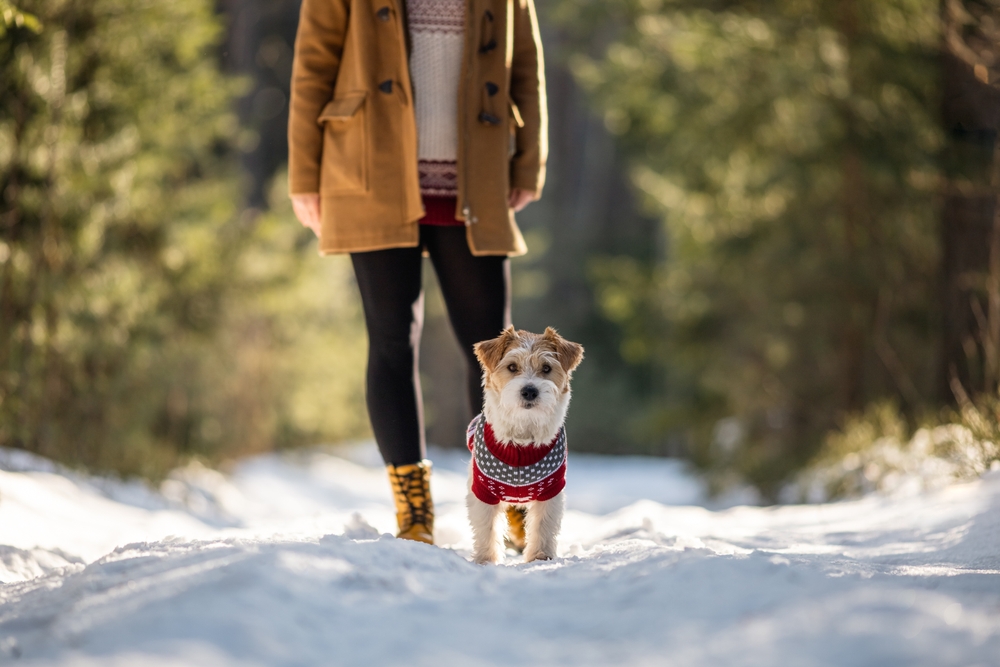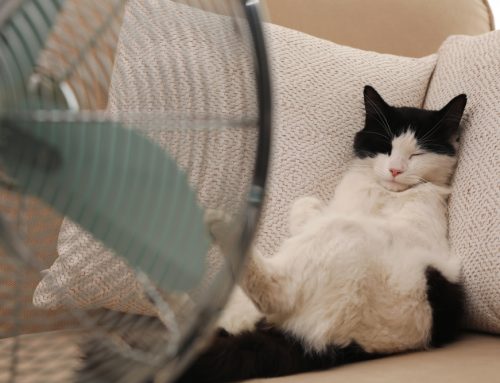Chilly temperatures and other winter hazards can put pets in danger. During this time of year, you need to take precautions to avoid a pet emergency. You don’t have to stay inside with your pet until spring, but you should consider your pet’s safety during winter activities. To help ensure you know how to keep your furry friend safe, happy, and warm this winter, our Town & Country Animal Hospital PC team is sharing good ideas and bad ideas regarding pet cold safety.
Good idea: Walking your pet on a winter day
Bad idea: Walking your pet on a freezing winter day
While pets need daily exercise year-round, your routine may need to change when temperatures dip. Thick fur or not, a pet who spends a prolonged time outside in freezing temperatures can easily develop frostbite and hypothermia. Limit your pet’s outdoor time when the temperature drops below 35 degrees, and keep them inside in below-freezing temperatures. Always monitor your pet outdoors and look for signs that they are too cold and need warmth. Signs include:
- Shivering
- Holding up their paws
- Moving slowly
- Limping
- Seeking shelter
Good idea: Dressing your pet in a sweater or coat
Bad idea: Assuming your pet’s fur is enough protection
While your pet has a fur coat to help keep them warm, no pet is immune to the cold. The following factors can increase a pet’s cold sensitivity:
- Breed and coat type — Some breeds have thick, insulating coats that are well-suited for cold weather, while others have short or thin coats that provide less protection. Breeds originating from cold climates tend to have better cold tolerance.
- Age — Extremely young and old cats and dogs often struggle to regulate their body temperature effectively, making them exceptionally susceptible to the cold.
- Size — Small pets have a high surface-area-to-weight ratio, which causes them to lose heat more quickly than large pets.
- Health — If your pet has a chronic health condition, such as diabetes, kidney failure, Cushing’s disease, or hypothyroidism, they may be more cold averse than a healthy pet.
Pets who are susceptible to cold, such as Chihuahuas or greyhounds, can benefit from an extra warmth layer. A well-fitted pet sweater or coat can trap in your pet’s body heat and protect them from the harsh elements
Good idea: Clearing snow and ice from areas on which your pet walks
Bad idea: Exposing your pet to harmful deicing chemicals
While keeping areas on which your pet walks clear of ice and snow can prevent them from slipping and falling, your removal method matters. Sidewalk and driveway ice-melting products can cause chemical burns on your pet’s paws. Additionally, if ingested, these chemicals can be toxic. To protect your pet from deicing products, follow these tips:
- Use pet-safe deicers. Some deicers don’t contain salt or chloride, making them safe for pets. Check the label to ensure the product is pet-friendly.
- Wipe your pet’s paws when they come inside to remove any chemical residue.
- Use paw balm for protection and to treat dry, cracked paw pads.
- Protect your pet’s paws with booties if they will tolerate wearing them.
Good idea: Providing a warm and cozy space inside
Bad idea: Leaving your pet in a parked car
Nothing feels better on a cold, blustery day than sitting indoors in front of a blazing fire. While you may be tempted to bring your pet along when you’re running errands, the safest place for your furry friend is cozy—and warm—at home. With little insulation, your vehicle is similar to a refrigerator, and temperatures inside can quickly drop. A pet who is left alone in a cold car for too long is at risk of rapidly becoming frostbitten or hypothermic, so leave your pet safe and warm at home when you run errands.
Good idea: Scheduling regular veterinary visits during the winter
Bad idea: Neglecting your pet’s health checkups

Routine wellness care is essential to your pet’s health year-round, and healthy pets are more cold tolerant. Pets should be assessed by a veterinary professional at least once a year. Pets are excellent at hiding illness and may not show outward signs until their condition is advanced. During a regular wellness visit, your pet’s veterinarian will perform a thorough physical examination and diagnostic tests to help detect health complications in the early stages when they are easier to treat and manage. Schedule a wellness exam to ensure your pet is winter ready.
Protect your pet this winter by following our good ideas, and feel free to contact our Town & Country Animal Hospital PC team with questions about cold weather pet safety, or to schedule your pet’s wellness exam.







Leave A Comment